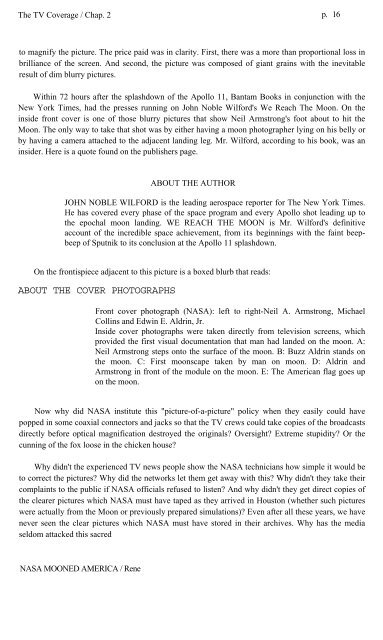Rene-NASA-Mooned-America
Rene-NASA-Mooned-America
Rene-NASA-Mooned-America
Create successful ePaper yourself
Turn your PDF publications into a flip-book with our unique Google optimized e-Paper software.
The TV Coverage / Chap. 2 p. 16<br />
to magnify the picture. The price paid was in clarity. First, there was a more than proportional loss in<br />
brilliance of the screen. And second, the picture was composed of giant grains with the inevitable<br />
result of dim blurry pictures.<br />
Within 72 hours after the splashdown of the Apollo 11, Bantam Books in conjunction with the<br />
New York Times, had the presses running on John Noble Wilford's We Reach The Moon. On the<br />
inside front cover is one of those blurry pictures that show Neil Armstrong's foot about to hit the<br />
Moon. The only way to take that shot was by either having a moon photographer lying on his belly or<br />
by having a camera attached to the adjacent landing leg. Mr. Wilford, according to his book, was an<br />
insider. Here is a quote found on the publishers page.<br />
ABOUT THE AUTHOR<br />
JOHN NOBLE WILFORD is the leading aerospace reporter for The New York Times.<br />
He has covered every phase of the space program and every Apollo shot leading up to<br />
the epochal moon landing. WE REACH THE MOON is Mr. Wilford's definitive<br />
account of the incredible space achievement, from its beginnings with the faint beepbeep<br />
of Sputnik to its conclusion at the Apollo 11 splashdown.<br />
On the frontispiece adjacent to this picture is a boxed blurb that reads:<br />
ABOUT THE COVER PHOTOGRAPHS<br />
Front cover photograph (<strong>NASA</strong>): left to right-Neil A. Armstrong, Michael<br />
Collins and Edwin E. Aldrin, Jr.<br />
Inside cover photographs were taken directly from television screens, which<br />
provided the first visual documentation that man had landed on the moon. A:<br />
Neil Armstrong steps onto the surface of the moon. B: Buzz Aldrin stands on<br />
the moon. C: First moonscape taken by man on moon. D: Aldrin and<br />
Armstrong in front of the module on the moon. E: The <strong>America</strong>n flag goes up<br />
on the moon.<br />
Now why did <strong>NASA</strong> institute this "picture-of-a-picture" policy when they easily could have<br />
popped in some coaxial connectors and jacks so that the TV crews could take copies of the broadcasts<br />
directly before optical magnification destroyed the originals Oversight Extreme stupidity Or the<br />
cunning of the fox loose in the chicken house<br />
Why didn't the experienced TV news people show the <strong>NASA</strong> technicians how simple it would be<br />
to correct the pictures Why did the networks let them get away with this Why didn't they take their<br />
complaints to the public if <strong>NASA</strong> officials refused to listen And why didn't they get direct copies of<br />
the clearer pictures which <strong>NASA</strong> must have taped as they arrived in Houston (whether such pictures<br />
were actually from the Moon or previously prepared simulations) Even after all these years, we have<br />
never seen the clear pictures which <strong>NASA</strong> must have stored in their archives. Why has the media<br />
seldom attacked this sacred<br />
<strong>NASA</strong> MOONED AMERICA / <strong>Rene</strong>


